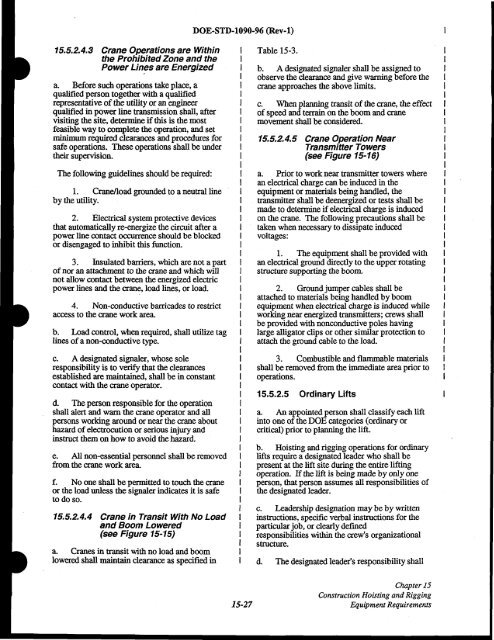DOE-STD-1090-96, DOE Standard Hoisting and Rigging Manual ...
DOE-STD-1090-96, DOE Standard Hoisting and Rigging Manual ...
DOE-STD-1090-96, DOE Standard Hoisting and Rigging Manual ...
Create successful ePaper yourself
Turn your PDF publications into a flip-book with our unique Google optimized e-Paper software.
<strong>DOE</strong>-<strong>STD</strong>-I090-<strong>96</strong> (Rev-I)15.5.2.4.3 Crane Operations are Withinthe ProhibitedZone <strong>and</strong> thePower Lines are Energizeda. Before such operations take place, aqualified person together with a qualifiedrepresentative ofthe utility or an engineerqualified in power line transmission shall, aftervisiting the site, determine ifthis is the mostfeasible way to complete the operation, <strong>and</strong> setminimum required clearances <strong>and</strong> procedures forsafe operations. These operations shall be undertheir supervision.The following guidelines should be required:1. Cranelload grounded to a neutral lineby the utility.2. Electrical system protective devicesthat automatically re-energize the circuit after apower line contact occurrence should beblockedor disengaged to inhibit this function.3. Insulated barriers, which are not a partofnor an attachment to the crane <strong>and</strong> which willnot allow contact between the energized electricpower lines <strong>and</strong> the crane, load lines, or load.4. Non-conductive barricades to restrictaccess to the crane work areab. Load control, when required, shall utilize taglines ofa non-conductive type.c. A designated signaler, whose soleresponsibility is to verify that the clearancesestablished are maintained, shall be in constantcontact with the crane operator.d. The person responsible for the operationshall alert <strong>and</strong> warn the crane operator <strong>and</strong> allpersons working around or near the crane abouthazard ofelectrocution or serious injury <strong>and</strong>instruct them on how to avoid the hazard.e. All non-essential personnel shall be removedfrom the crane work area.f. No one shall be permitted to touch the craneor the load unless the signaler indicates it is safeto do so.15.5.2.4.4 Crane in Transit With No Load<strong>and</strong> Boom Lowered(see Figure 15-15)a. Cranes in transit with no load <strong>and</strong> boomlowered shall maintain clearance as specified inTable 15-3.b. A designated signaler shall be assigned toobserve the clearance <strong>and</strong> give warning before thecrane approaches the above limits.c. When planning transit ofthe crane, the effectof speed <strong>and</strong> terrain on the boom <strong>and</strong> cranemovement shall be considered.15.5.2.4.5 Crane Operation NearTransmitter Towers(see Figure 15-16)a. Prior to work near transmitter towers wherean electrical charge can be induced in theequipment or materials being h<strong>and</strong>led, thetransmitter shall be deenergized or tests shall bemade to determine ifelectrical charge is inducedon the crane. The following precautions shall betaken when necessary to dissipate inducedvoltages:1. The equipment shall be provided withan electrical ground directly to the upper rotatingstructure supporting the boom.2. Ground jumper cables shall beattached to materials being h<strong>and</strong>led byboomequipment when electrical charge is induced whileworking near energized transmitters; crews shallbe provided with nonconduetive poles havinglarge alligator clips or other similar protection toattach the ground cable to the load.3. Combustible <strong>and</strong> flammable materialsshall be removed from the immediate area prior tooperations.15.5.2.5 Ordinary Liftsa. An appointed person shall classify each liftinto one of the <strong>DOE</strong> categories (ordinary orcritical) prior to planning the lift.b. <strong>Hoisting</strong> <strong>and</strong> rigging operations for ordinarylifts require a designated leader who shall bepresent at the lift site during the entire liftingoperation. Ifthe lift is being made by only oneperson, that person assumes all responsibilities ofthe designated leader.c. Leadership designation may be by writteninstructions, specific verbal instructions for theparticular job, or clearly defmedresponsibilities within the crew's organizationalstructure.d. The designated leader's responsibility shall15-27Chapter 15Construction <strong>Hoisting</strong> <strong>and</strong> <strong>Rigging</strong>Equipment Requirements
















